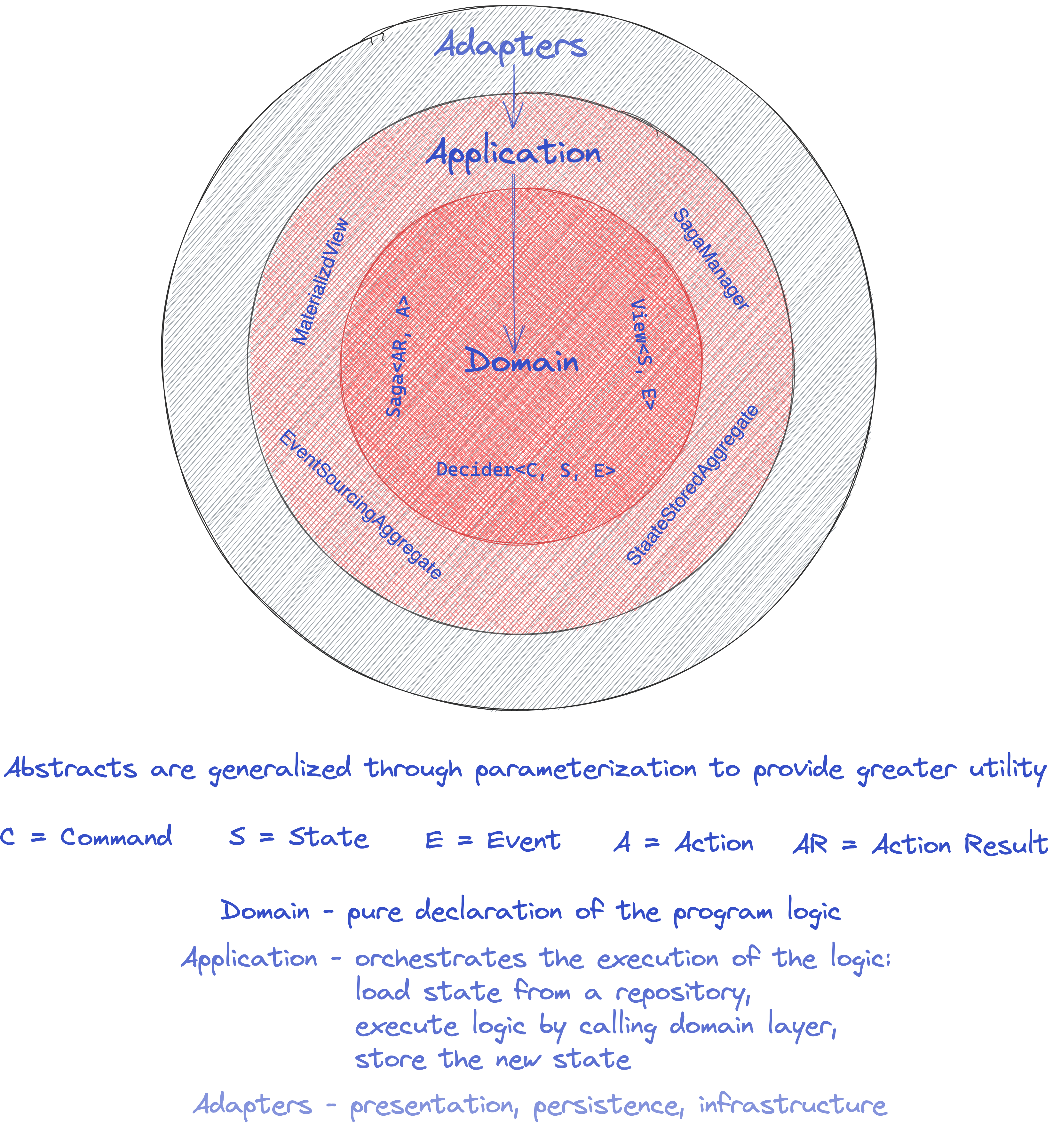
(model) - Functional Domain Modeling with RustWhen you’re developing an information system to automate the activities of the business, you are modeling the business. The abstractions that you design, the behaviors that you implement, and the UI interactions that you build all reflect the business — together, they constitute the model of the domain.

IOR<Library, Inspiration>This project can be used as a library, or as an inspiration, or both. It provides just enough tactical Domain-Driven Design patterns, optimised for Event Sourcing and CQRS.
Abstractions can hide irrelevant details and use names to reference objects. It emphasizes what an object is or does rather than how it is represented or how it works.
Generalization reduces complexity by replacing multiple entities which perform similar functions with a single construct.
Abstraction and generalization are often used together. Abstracts are generalized through parameterization to provide more excellent utility.
type DecideFunction<'a, C, S, E> = Box<dyn Fn(&C, &S) -> Vec<E> + 'a + Send + Sync>On a higher level of abstraction, any information system is responsible for handling the intent (Command) and based on
the current State, produce new facts (Events):
State/S on the input,Command/C is handled on the input,flow of new Events/E to be published/emitted on the outputtype EvolveFunction<'a, S, E> = Box<dyn Fn(&S, &E) -> S + 'a + Send + Sync>The new state is always evolved out of the current state S and the current event E:
State/S on the input,Event/E is handled on the input,State/S to be published on the outputTwo functions are wrapped in a datatype class (algebraic data structure), which is generalized with three generic parameters:
rust
pub struct Decider<'a, C: 'a, S: 'a, E: 'a> {
pub decide: DecideFunction<'a, C, S, E>,
pub evolve: EvolveFunction<'a, S, E>,
pub initial_state: InitialStateFunction<'a, S>,
}
Decider is the most important datatype, but it is not the only one. There are others:

Decider is a datatype/struct that represents the main decision-making algorithm. It belongs to the Domain layer. It
has three
generic parameters C, S, E , representing the type of the values that Decider may contain or use.
Decider can be specialized for any type C or S or E because these types do not affect its
behavior. Decider behaves the same for C=Int or C=YourCustomType, for example.
Decider is a pure domain component.
C - CommandS - StateE - Event```rust
pub type DecideFunction<'a, C, S, E> = Box
pub struct Decider<'a, C: 'a, S: 'a, E: 'a> { pub decide: DecideFunction<'a, C, S, E>, pub evolve: EvolveFunction<'a, S, E>, pub initial_state: InitialStateFunction<'a, S>, } ```
Additionally, initialState of the Decider is introduced to gain more control over the initial state of the Decider.
Event sourcing aggregate is using/delegating a Decider to handle commands and produce new events.
It belongs to the
Application layer. In order to
handle the command, aggregate needs to fetch the current state (represented as a list/vector of events)
via EventRepository.fetchEvents async function, and then delegate the command to the decider which can produce new
events as
a result. Produced events are then stored via EventRepository.save async function.
It is a formalization of the event sourced information system.
State stored aggregate is using/delegating a Decider to handle commands and produce new state. It
belongs to the
Application layer. In order to
handle the command, aggregate needs to fetch the current state via StateRepository.fetchState async function first,
and then
delegate the command to the decider which can produce new state as a result. New state is then stored
via StateRepository.save async function.
View is a datatype that represents the event handling algorithm, responsible for translating the events into
denormalized state, which is more adequate for querying. It belongs to the Domain layer. It is usually used to create
the view/query side of the CQRS pattern. Obviously, the command side of the CQRS is usually event-sourced aggregate.
It has two generic parameters S, E, representing the type of the values that View may contain or use.
View can be specialized for any type of S, E because these types do not affect its behavior.
View behaves the same for E=Int or E=YourCustomType, for example.
View is a pure domain component.
S - StateE - Eventrust
pub struct View<'a, S: 'a, E: 'a> {
pub evolve: EvolveFunction<'a, S, E>,
pub initial_state: InitialStateFunction<'a, S>,
}
Materialized view is using/delegating a View to handle events of type E and to maintain
a state of denormalized
projection(s) as a
result. Essentially, it represents the query/view side of the CQRS pattern. It belongs to the Application layer.
In order to handle the event, materialized view needs to fetch the current state via ViewStateRepository.fetchState
suspending function first, and then delegate the event to the view, which can produce new state as a result. New state
is then stored via ViewStateRepository.save suspending function.
Cargo is Rust’s build system and package manager. We can use it to test and build the library:
shell
cargo test
Special credits to Jérémie Chassaing for sharing his research
and Adam Dymitruk for hosting the meetup.
Created with :heart: by Fraktalio